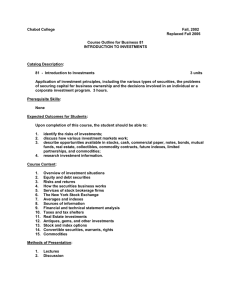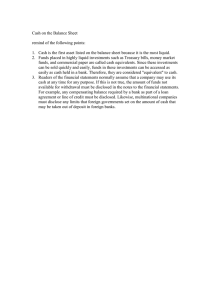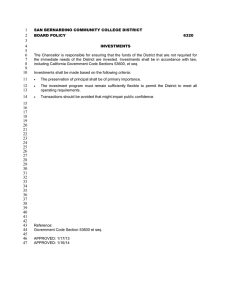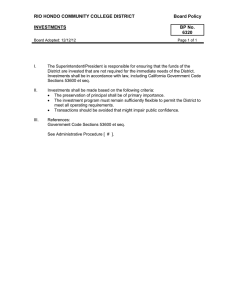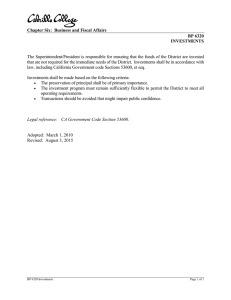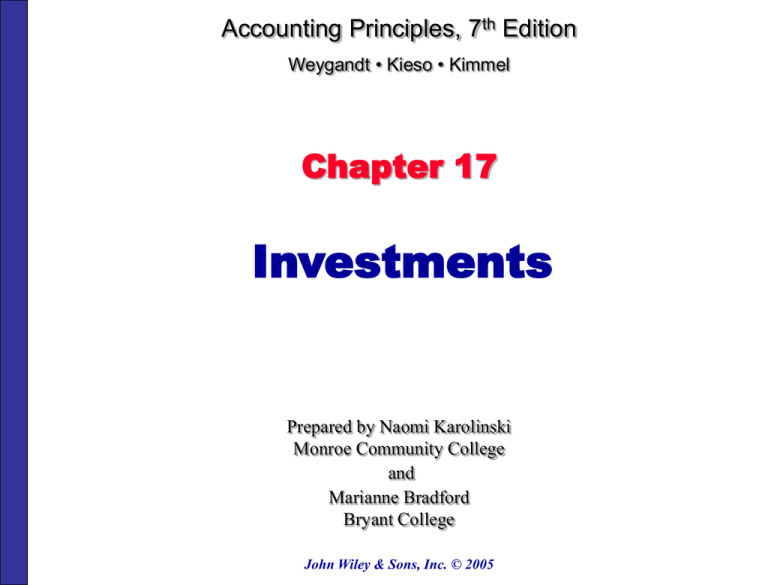
Accounting Principles, 7th Edition
Weygandt • Kieso • Kimmel
Chapter 17
Investments
Prepared by Naomi Karolinski
Monroe Community College
and
Marianne Bradford
Bryant College
John Wiley & Sons, Inc. © 2005
CHAPTER 17
INVESTMENTS
After studying this chapter, you should be able to:
1 Discuss why corporations invest in debt and stock
securities.
2 Explain the accounting for debt investments.
3 Explain the accounting for stock investments.
4 Describe the use of consolidated financial statements.
5 Indicate how debt and stock investments are valued
and reported on the financial statements.
6 Distinguish between short-term and long-term
investments.
TEMPORARY INVESTMENTS
AND THE OPERATING CYCLE
STUDY OBJECTIVE 1
•
At the end of the operating cycle
– temporary idle cash on hand available until the start of the next
operating cycle.
– invest the excess funds to earn a greater return.
•
The relationship of temporary investments to the
operating cycle is depicted below.
Cash
Accounts
Receivable
Invest
Sell
Inventory
Temporary
Investments
WHY CORPORATIONS
INVEST
ACCOUNTING FOR DEBT INVESTMENTS
RECORDING AQUISITION OF BONDS
STUDY OBJECTIVE 2
Debt investments are investments in government and
corporation bonds. Three entries required:
1) acquisition- the cost principle applies
2) interest revenue
3) sale
Kuhl Corporation acquires 50 Doan Inc. 8%, 10-year, $1,000 bonds on
January 1, 2005, for $54,000, including brokerage fees of $1,000.
The entry to record the investment is:
Date
Jan. 1
Account Titles and Explanation
Debt Investments
Cash
(To record purchase of 50 Doan Inc. bonds)
Debit
Credit
54,000
54,000
ACCOUNTING FOR DEBT INVESTMENTS
RECORDING BOND INTEREST
The bonds pay $3,000 interest on July 1 and January 1
($50,000 x 12% x ½). The July 1 entry is:
Date
July 1
Account Titles and Explanation
Cash
Interest Revenue
(To record receipt of interest on Doan Inc.
bonds)
Debit
Credit
2,000
2,000
It is necessary to accrue $3,000 interest earned since July 1
at year-end. The December 31 entry is:
Date
Account Titles and Explanation
Dec. 31 Interest Receivable
Interest Revenue
(To accrue interest on Doan Inc. bonds)
Debit
Credit
2,000
2,000
ACCOUNTING FOR DEBT INVESTMENTS
RECORDING BOND INTEREST
When the interest is received on January 1, the entry is:
Date
Jan. 1
Account Titles and Explanation
Cash
Interest Receivable
(To record receipt of accrued interest)
Debit
Credit
2,000
2,000
ACCOUNTING FOR DEBT
INVESTMENTS
RECORDING SALE OF BONDS
Any difference between the net proceeds from the sale
(sales price less brokerage fees) and the cost of the bonds
is recorded as a gain or loss.
Kuhl Corporation receives net proceeds of $58,000 on the sale of
the Doan Inc. bonds on January 1, 2006, after receiving the interest
due. Since the securities cost $54,000, a gain of $4,000 has been
realized.
Date
Jan. 1
Account Titles and Explanation
Cash
Debt Investments
Gain on Sale of Debt Investments
(To record sale of Doan Inc. bonds)
Debit
Credit
58,000
54,000
4,000
Debt investments are initially recorded at:
a. cost.
b. cost plus accrued interest.
c. fair value.
d. None of the above.
Debt investments are initially recorded at:
a. cost.
b. cost plus accrued interest.
c. fair value.
d. None of the above.
ACCOUNTING GUIDELINES
FOR STOCK INVESTMENTS
STUDY OBJECTIVE 3
Stock dividends are investments in the capital stock of corporations.
RECORDING STOCK INVESTMENTS
HOLDINGS LESS THAN 20%
Cost Method: Stock investments of less than 20%
• investment recorded at cost
• revenue recognized only when cash dividends are
received
On July 1, 2005, Sanchez Corporation acquires 1,000 shares (10%
ownership) of Beal Corporation common stock. Sanchez pays $40
per share plus brokerage fees of $500. The entry for the purchase is:
Date
July 1
Account Titles and Explanation
Stock Investments
Cash
(To record purchase of 1,000 shares of Beal
Corporation common stock)
Debit
Credit
40,500
40,500
RECORDING STOCK INVESTMENTS
HOLDINGS LESS THAN 20%
Entries are required for any cash dividends
received during the time the stock is held. If a
$2 per share dividend is received by Sanchez
Corporation on December 31, the entry is:
Date
Dec. 31
Account Titles and Explanation
Cash (1,000 x $2)
Dividend Revenue
(To record receipt of a cash dividend)
Debit
Credit
2,000
Dividend Revenue is reported under Other
Revenue and Gains in the income statement.
Since dividends do not accrue, adjusting entries
are not made to accrue dividends.
2,000
RECORDING STOCK
INVESTMENTS
HOLDINGS LESS THAN 20%
• Stock is sold
– difference between the net proceeds from the sale
and the cost of the stock is recognized as a gain or
loss.
• Sanchez Corporation receives net proceeds of $39,500 on
the sale of its Beal Corporation common stock on
February 10, 2006.
• Because the stock cost $40,500, a loss of $1,000 has been
incurred. The entry to record the sale is:
Date
Feb. 10
Account Titles and Explanation
Cash
Loss on Sale of Stock Investments
Stock Investments
(To record sale of Beal common stock)
Debit Credit
39,500
1,000
40,500
ACCOUNTING FOR STOCK
INVESTMENTS
HOLDINGS BETWEEN 20% AND 50%
• Investor has significant influence over the financial and
operating activities of the investee.
• Equity method
– investment in common stock is recorded at cost
– investment account adjusted annually to show the
investor’s equity in the investee
• The investor
1) debits the investment account and credits revenue for
its share of the investee’s net income
2) credits dividends received to the investment account
ACCOUNTING FOR STOCK INVESTMENTS
HOLDINGS BETWEEN 20% AND 50%
Milar Corporation acquires 30% of the
common stock of Beck Company for
$120,000 on January 1, 2005 The entry to
record this transaction is:
Date
Jan. 1
Account Titles and Explanation
Stock Investments
Cash
(To record purchase of Beck common
stock)
Debit
Credit
120,000
120,000
ACCOUNTING FOR STOCK
INVESTMENTS
HOLDINGS BETWEEN 20% AND 50%
Beck reports 2005 net income of $100,000 and declares and pays
a $40,000 cash dividend. Milar is required to record:
1) its share of Beck’s net income, $30,000 (30% X $100,000) and
2) the reduction in the investment account for the dividends
received, $12,000 ($40,000 X 30%). The entries are:
Date
Dec. 31
Date
Dec. 31
Account Titles and Explanation
Stock Investments
Revenue from Investment in Beck Company
(To record 30% equity in Beck’s 2002 net
income)
Account Titles and Explanation
Cash
Stock Investments
(To record dividends received)
Debit
30,000
Credit
30,000
Debit
Credit
12,000
12,000
INVESTMENT AND REVENUE
ACCOUNTS AFTER POSTING
January 1
December 31
December 31 Balance
Stock Investments
120,000 December 31
30,000
138,000
Revenue from Investment in Beck Company
December 31
12,000
30,000
Investment and revenue accounts will show the above results.
The investment account has increased by $18,000 which
represents Milar’s 30% equity in the $60,000 increase in Beck’s
retained earnings ($100,000 - $40,000). Milar will also report
$30,000 of revenue from its investment, which is 30% of Beck’s
net income of $100,000. Milar would report only $12,000 (30%
X $40,000) of dividend revenue if the cost method were used.
RECORDING STOCK INVESTMENTS
HOLDINGS OF MORE THAN 50%
STUDY OBJECTIVE 4
• Company owns more than 50% of the
common stock of another entity
– is known as a parent company
• Entity whose stock is owned by the parent
company
– is the subsidiary (affiliated) company.
• The parent company
– controlling interest in the subsidiary due to its
stock ownership
– prepares consolidated financial statements
RECORDING STOCK INVESTMENTS
MANAGEMENT PERSPECTIVE
Time Warner, Inc. own 100% of the common stock of Home Box Office (HBO).
The common stockholders of Time Warner elect the board of directors of the
company, who, in turn, select the officers and managers of the company. The
Board of Directors controls the property owned by the corporation, which includes
the common stock of HBO.
VALUATION GUIDELINES
STUDY OBJECTIVE 5
Fair value is the amount for which a security could be sold in a
normal market and offers the best approach at investment
valuation since it represents the expected cash realizable value
of the securities.
CATEGORIES OF
SECURITIES
•
Trading securities
bought and held primarily for sale in the near
term to generate income on short-term price
differences
•
Available-for-sale securities
may be sold in the future
•
Held-to-maturity securities
debt securities that the investor has intent and
ability to hold to maturity
VALUATION OF TRADING
SECURITIES
• Trading securities (generally less than a month)
– reported at fair value, and changes from cost are reported as part of net
income.
• Changes reported as unrealized gains or losses since the securities
have not been sold
– difference between the total cost of trading securities and their total fair
value.
• Pace Corporation has the following costs and fair values for its
investments classified as trading securities:
Trading Securities, December 31, 2005
Investments
Yorkville Company bonds
Kodak Company stock
Total
Cost
Fair Value Unrealized Gain (Loss)
$ 50,000
$ 48,000
$ (2,000)
90,000
99,000
9,000
$ 140,000
$ 147,000
$ 7,000
VALUATION AND REPORTING OF
INVESTMENTS — TRADING
SECURITIES
•Unrealized gain of $7,000
• total fair value ($147,000) is $7,000 greater than total
cost ($140,000)
•Fair value and the unrealized gain or loss
• adjusting entry at the time financial statements are
prepared
•Valuation allowance account-Market Adjustment–Trading
• records the difference between the total cost and the
total fair value of the securities.
Date
Dec. 31
Account Titles and Explanation
Market Adjustment — Trading
Unrealized Gain — Income
(To record unrealized gain on trading
securities)
Debit
Credit
7,000
7,000
VALUATION AND REPORTING OF
INVESTMENTS — TRADING
SECURITIES
1 Fair value
–
On the balance sheet
2 Unrealized gain
–
Income statement
3 Unrealized loss
–
Income statement
VALUATION OF
AVAILABLE-FOR-SALE
SECURITIES
• Available-for-sale securities (the intention of selling them in the
near future)
– reported at fair value, and changes from cost are reported as part of net
income.
• Changes reported as unrealized gains or losses since the securities
have not been sold.
– The unrealized gain or loss is the difference between the total cost of the
securities in the category and their total fair value.
• Elbert Corporation has the following costs and fair values for its
investments classified as available-for-sale securities:
Available-for-Sale Securities, December 31, 2005
Investments
Campbell Soup Corporation 8% bonds
Hersey Corporation stock
Total
Cost
Fair Value Unrealized Gain (Loss)
$ 93,537
$ 103,600
$ 10,063
200,000
180,400
(19,600)
$ 293,537
$ 284,000
$ ( 9,537)
VALUATION AND REPORTING OF
AVAILABLE-FOR-SALE
SECURITIES
INVESTMENTS
Elbert Corporation has an unrealized loss of $9,537 total fair
value $284,000 (total cost - $293,537).
Fair value and the unrealized gain or loss
– recorded through an adjusting entry at the time financial
statements are prepared
The adjusting entry for Elbert Corporation is:
Date
Dec. 31
Account Titles and Explanation
Unrealized Loss — Equity
Market Adjustment — Available-for-Sale
(To record unrealized loss on
available-for-sale securities)
Debit
Credit
9,537
9,537
VALUATION AND REPORTING OF
AVAILABLE-FOR-SALE
SECURITIES
INVESTMENTS
1 Fair value of the securities
– reported on the balance sheet
2 Unrealized gain or loss
– reported as a separate component of
stockholders’ equity
SHORT-TERM INVESTMENTS
STUDY OBJECTIVE 5
Securities held by a company
(1) readily marketable
– can be sold easily when the need for cash
arises
(2) intended to be converted into cash within
the next year or operating cycle, whichever
is longer
– intent to sell the investment within the next
year or operating cycle, whichever is longer
PRESENTATION OF SHORTTERM INVESTMENTS
Short Term investments
• listed immediately below cash in the current
asset section of the balance sheet
• reported at fair value
PACE CORPORATION
Balance Sheet (partial)
Current assets
Cash
Short-term Investments at fair value
$ 21,000
147,000
NONOPERATING ITEMS
RELATED TO INVESTMENTS
• Long-term investments are reported in a separate
section of the balance sheet immediately below
current assets
• The items below are reported in the nonoperating
section of the income statement:
Other Revenues and Gains
Interest Revenue
Dividend Revenue
Gain on Sale of Investments
Unrealized Gain – Income
Other Expenses and Losses
Loss on Sale of Investments
Unrealized Loss – Income
UNREALIZED LOSS IN
STOCKHOLDERS’ EQUITY
SECTION
• An unrealized gain or loss on available-for-sale securities is
reported as a separate component of stockholders’ equity.
• Dawson Inc. has common stock of $3,000,000, retained earnings of
$1,500,000, and an unrealized loss on available-for-sale securities of
$100,000.
• The statement presentation of the unrealized loss is shown below.
DAWSON INC.
Partial Balance Sheet
Stockholders’ equity
Common stock
Retained earnings
Total paid-in capital and retained earnings
Less: Unrealized loss on available-for-sale securities
Total stockholders’ equity
$ 3,000,000
1,500,000
4,500,000
( 100,000)
$ 4,400,000
COMPREHENSIVE BALANCE
SHEET
The comprehensive
balance sheet for
Pace Corporation
includes the
following assets:
1 Short-term
Investments,
2 Investments of
less than 20%,
and
3 Investments of
20% - 50%.
COMPREHENSIVE BALANCE
SHEET
The
comprehensive
balance sheet for
Pace Corporation
includes the
following element
of stockholders’
equity:
Unrealized Gain
on
Available-for-Sale
Securities.
In the balance sheet, a debit balance in
Unrealized Gain or Loss – Equity is
reported as a::
a. contra asset account.
b. contra stockholders’ equity account.
c. loss in the income statement.
d. loss in the retained earnings statement.
In the balance sheet, a debit balance in
Unrealized Gain or Loss – Equity is
reported as a:
a. contra asset account.
b. contra stockholders’ equity account.
c. loss in the income statement.
d. loss in the retained earnings statement.
COPYRIGHT
Copyright © 2005 John Wiley & Sons, Inc. All rights reserved. Reproduction
or translation of this work beyond that permitted in Section 117 of the 1976
United States Copyright Act without the express written consent of the
copyright owner is unlawful. Request for further information should be
addressed to the Permissions Department, John Wiley & Sons, Inc. The
purchaser may make back-up copies for his/her own use only and not for
distribution or resale. The Publisher assumes no responsibility for errors,
omissions, or damages, caused by the use of these programs or from the use
of the information contained herein.


